| |
PRASHANTI DIARY
CHRONICLES OF HEAVEN ON EARTH
A SPECIAL REPORT FROM SWAMI’S ABODE IN BRINDAVAN
It was a pleasing time, it was a heavenly time, but all good things had to come to an end. After a very special and enchanting 15-day stay in Kodaikanal, Swami left this place of enchanting beauty on April 23rd and emplaned for His summer residence of Brindavan, in the suburbs of Whitefield, Bangalore. There is so much to share with you about the wonderful happenings in Kodai Kanal that we have decided to have a series of articles on Kodai Kanal entitled “With The Lord In The Mountains” starting from the next issue. In every issue from July, you will get a drop of the Divine Nectar that was Swami’s visit to Kodai. Also if you have not seen the photo Album of this issue, we have some enchanting snaps of Bhagawan in Kodai Kanal and this time the Photo Album is really unique because it is dynamic. We will be changing the Photo Album with a fresh set of nine pictures everyday almost till the end of June. So you are going to get immersed with Sai in the sylvan surroundings of Kodai Hills. For now, we continue to report on His activities during His stay in Brindavan after He returned from Kodai Kanal.
No sooner did He settle in, and then it was time for a celebration. “Trayee Brindavan”, Swami’s Divine Abode in Brindavan had been inaugurated on April 26th, 1984; so it was time for a special remembrance - the celebration of its 22nd anniversary.
APRIL 26TH: “TRAYEE DAY” CELEBRATIONS IN BRINDAVAN, BANGALORE
The Morning Programme
Every year, this anniversary is traditionally celebrated with great fervour with bhajans and Narayan Seva on April 26th if Swami is resident in Brindavan.
The morning started as usual, with the Divine darshan. The entire dais had been well decorated with floral garlands and wreaths even at such short notice as Swami had only returned a couple of days earlier from Kodaikanal. The early morning celebrations started on an auspicious note with Mangala Vadhyam (Nadaswaram music) by a bunch of dedicated musicians in front of Trayee Brindavan. The public were treated to a delightful mix of bhajans sung by the Institute students who had sacrificed their holidays and elected to spend it with the Lord. After about an hour of bhajans, mangala arathi was taken and prasadam was distributed to one and all.
|
|
|
The Nadaswaram Music |
|
The Divine Darshan |
But the morning’s festivities did not end there. More was on the agenda, which however most of the public did not get to see. As Swami was returning to His residence, the Bangalore Seva Dal obtained His blessings to do Narayana Seva (distribution of prasadam - a sumptuous plate of sambar rice and sakarra pongal – sweet rice - to the underprivileged) and vastra dhanam (giving of clothes to the needy) to benefit about 400 persons from the neighbourhood.
|
|
|
Bangalore Sevadal getting blessings... |
|
Prasadam for the crowd |
Another tradition that is not normally visible to the public is that on this day the students and some of the staff resident in Brindavan decorate a portion of the garden in front of the Divine Abode. Swami usually spends some time viewing these decorations when He returns after the morning darshan, and also poses for photographs with the boys who had laboured through the previous night to win His approval.
Every year the theme varies. This year the theme was “Garden of Love” – a specially decorated chair was laid for Swami in the centre and a circular “garden” was laid around it with a decorated entrance and a back-drop.
Swami entered this circular garden, cut a cake that the boys had prepared for Him and posed for the coveted photographs. Thus the morning celebrations came to a close.
The Afternoon Programme
In the afternoon, a programme of devotional songs was presented by the mahilas (ladies) of the Brindavan Bhajan Group.
|
|
|
This bhajan group has a hoary history and was started in December 1968, soon after Swami’s return from East Africa, and they started singing bhajans under the mango tree inside Swami’s residence at that time. Later on Ugadi day – March 19, 1969, the official Brindavan Bhajan Group, started bhajan singing – on Thursdays and Sundays when Swami is resident in Brindavan. When Swami is not physically in Brindavan, the bhajans are sung on Sundays. Presently the Brindavan Group consists of 100 singers and accompanists, out of which 57 are ladies and the other 43 are gents.
 |
|
The ladies’ programme, containing songs of praise to Swami in many Indian languages, started with an obeisance to Mother Easwaramma with the Hindi song Janam Diya. This song offers salutations to Mother Easwaramma for conferring on us the boon of the Sai Avathar.
This was followed by a Kannada song called Prema Swaroopa Hey Jagannatha. This song goes thus – “Oh! Embodiment of Love; salutations to You. You are the Lord of the temple of our hearts; we are like the dust of Your Holy Feet. Relieve us Sai Krishna from the bondage of birth and death”.
Kantrinile Varum Geetam, a Tamil song expressed the sentiment - What in this world has the power to melt a stone, to breathe life into a dying tree and to mesmerize all the birds and beasts. Only the divine music from Sai Krishna’s flute can inspire such wonders.
|
The Ladies Bhajan Group |
|
|
Saans Saans Mein a Hindi song exhorted the Lord to help us remember Him with every breath; the Sanskrit Dheera Sameera Yamuna Theere expressed a prayer to keep us away from all that keeps us away from You; singing the glory of Sai with the Malayalam Brindavanathille Sai which says that Your enchanting darshan as Brindavana Sai Krishna makes us forget ourselves.
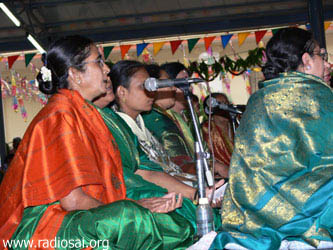 |
|
Sundarathe Dhyana in Marathi asks dear Swami to let Your beautiful form be ever affixed in our hearts and Your sacred name for ever be on our lips.
Adivo Alladivo Srihari Vaasamu (in Telugu) said that Trayee Brindavan is the sacred abode of Sai Srihari, chanting Your divine Name is incomparable to any worldly wealth.
The ladies finally expressed gratitude to Swami in Hindi with Kaise Bataayein – Bhagavan, how can we express our good fortune for we are here with You dear Lord. Innumerable are our follies, but Your mercy exceeds them all. None so high or low, we are all one in the Kingdom of Sai. We express our gratitude Swami, for accepting us at Your Lotus Feet.
|
Singing bhajans for the Lord |
|
|
After this arathi was taken and the formal programme in Sai Ramesh Hall concluded with the distribution of prasadam.
But the evening’s programme was not yet over! Two years ago, on April 26th, 2004, Swami graciously acceding to the prayers of the devotees had permitted Deepalankara of Trayee Brindavan, i.e. nearly a lakh (100,000) candles were lit all over the ashram campus – in front of Trayee, Sai Ramesh Hall, the Kalyana Mantap, the space in front of the two Hostels, the Guest Houses as well as the pathways along the Residential Blocks.
On that occasion hundreds of devotees participated in the lighting of the candles with great love and reverence, and Swami also responded by driving around Trayee, showering His Grace on one and all.
|
|
|
In continuing with that tradition, this year too, later in the evening after the Sun had gone down, “Sai Akhanda Jyothi” was alight with thousands of candles – in and around Trayee and all around the Ashram complex. All the devotees – both men and women – participated in lighting the candles. The entire Ashram campus was aglow with the light from the thousands of candles and also the multi-coloured electric light bulbs. All who had the fortune to be present and witness the grand spectacle of the illuminated Brindavan felt that this was indeed the “Bhooloka Vaikuntham” or Heaven on Earth!
|
|
|
The Lights in Sai Ramesh Hall |
|
Lights in front of the Kalyana mantap |
Swami came out in the balcony late during the evening and sat for a few minutes witnessing the lights from all sides and giving a special darshan to all those who were waiting for Him after lighting the jyothis.
April 27TH 2006: A STUDENT SPEAKS TO THE CROWD
It was the first Thursday after Swami had returned from Kodaikanal. An expectant crowd had collected to sing bhajans and spend this holy day in the divine presence. After listening to the bhajan singing for a few minutes Swami blessed Sri Sanjay Mahalingam, a student pursuing his Ph.D. in Management in the Prashanti Nilayam campus of the Sri Sathya Sai Institute of Higher Learning (SSSIHL) to address the crowd.
|
|
|
Sri Sanjay Mahalingam addressing the crowd |
|
Singing "Paiyo ji maine ram rathan..." |
Sri Sanjay opined that only God can give us true, absolute and unsullied love. The love that knows only to say “Yes, Yes, Yes”. He said that to seek God is the only purpose of life and to attain God is the culmination of life. A wise man has only one desire to become one with God. Raising the question “Who is God?” - he answered that the only God that ever exists is our own, true self. We should hence pursue who we are till we attain the realization that we are the subject and not the object. Quoting extensively from the shastras, Sri Sanjay showed that all problems stem from false identification with the body.
After this brief but well received speech, Swami blessed some of the students of the Sai Mirpuri College of Music to sing some Meera bhajans. The boys sang three haunting bhajans for the crowd: Mere to Giridhar Gopal, Payoji maine Ram rathan dhan payo, and Krishna, Krishna darshan dijo aaj pyaare. They ended this concert with the popular group song Hum ko tumse pyar hai.
MAY 2ND: A DIVINE DISCOURSE
Unexpected and inexplicable are the ways of the Lord. Seeing the devotion with which the people of Bangalore had received Him on his return to the city, the Lord felt moved to address them. So an announcement was made a day prior that Swami would be addressing everyone on the evening of May 2nd at 4 PM. A very big crowd had collected to listen to this unexpected but very welcome benedictory message from our dear Lord.
Swami first blessed Sri Sanjay Sahni, Principal of the Brindavan campus of the SSSIHL, to address the crowd prior to His Divine Discourse.
Sri Sanjay Sahni said that coming to Bhagavan is like a homecoming. The greatest adventure in life is to seek God, and the greatest fulfilment in life is to attain Him. Just as we mark our progress in a journey by the milestones we pass, in the spiritual journey of life too we have several milestones, milestones that Bhagavan has beautifully elaborated as Salokyam,Sameepyam, Saroopyam and Sayujyam.
Sa means divine. Hence Salokyam refers to the divine loka (planet). Sri Sahni said that once the late Dr. Hislop asked Swami what the 14 lokas are. Swami replied that the 14 lokas are the 14 levels of thought – 7 levels of thought towards the divine and 7 levels of thought away from the divine.
|
|
|
| |
|
Sri Sanjay Sahni addressing the crowd |
Sri Sahni further added, “If we think of Bhagavan, we are in His presence. How much of our thoughts we give to Him? In the beginning even 10 minutes may take a lot of effort, but with persistent practise soon our thoughts flow naturally towards Him”. He then said that the next stage is Sameepyam or proximity of the Lord. If you want to have sannidhi (nearness) of the Lord, you must participate in His mission. The third stage is Saroopyam, the stage of dearness to the Lord when you acquire His characteristics. This was the stage reached by Bharatha, who contemplated so deeply on the Lord when Sri Rama was in exile for 14 years, that He looked just like Him and the people of Ayodhya could not differentiate between them. In conclusion, Sri Sanjay said that even Saroopyam is duality. The last stage is Sayujyam or merger with the Lord. This final stage is attained only with the Lord’s Grace.
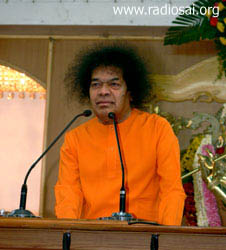 |
|
Swami in His Divine Discourse chose to speak on a topic dear to His Heart – the 4 Human Values of Sathya, Dharma, Shanti and Prema. He said that the result of attaining high levels of education, the value of noble and charitable acts and the reward for all kinds of good deeds all come to naught if man is bereft of these 4 human values of Truth, Right Conduct, Peace and Love. These 4 values are the pillars which support the mansion of Sanathana Dharma (the Perennial Philosophy), He asserted.
He next touched upon the meaning of the descent of the Avatar. The descent of God is the act of coming down to the world with love for man, and He becomes one with him. God comes down to earth in order to set ideals for mankind and to lead them on the righteous path. And to achieve oneness with man He chooses to come down in a human form. For any achievement in the world, wealth and property is required as nothing can be accomplished without worldly instruments and implements. God however, is beyond the desires of the body and the mind and free of qualities like anger. Everything He does and says is only for the redemption of man. |
The Divine Discourse |
|
|
Swami next emphasized that all of us are divine. He said, “If somebody asks – Who are you? – then you have to answer, “I am I” and not with the name given to the body”. He further said that except for the entity ‘I’ in everyone, everything else is imaginary. God resides in all and He is the one that has become the many. The ‘I’ exists in everyone; society itself is a conglomeration of individuals; the individual is God and God alone and hence society itself has emerged from God. He said that God is in our own heart and by practising the 4 human values, we can recognize God. First and foremost we have to understand that we are God. Till we attain this divine experience, we will be unable to give up body identification.
On a cautionary note, Swami said that God Himself has prescribed limits for every man. In this world everything is limited and it is only when we cross these limits that we undergo difficulties. It is because of a lack of control that we have no limits for our desires. He exhorted all to reduce sensual desires and to cultivate patience and courage. “Whatever may change, Truth will never change”, He said. He further added that Truth and Love are both within you. So by developing Love we will always be peaceful. Swami ended His discourse by singing the bhajan - “Prema mudhitha manasa kaho….”
MAY 6th: EASWARAMMA DAY CELEBRATIONS
The Morning Programme – Bhajans By The Bala Vikas Children and Narayan Seva
Traditionally, Easwaramma Day celebrations in Brindavan are essentially a children’s activity. Leading up to the special day, the Bala Vikas children belonging to the Education Wing of the Sri Sathya Sai Organizations of the Bangalore Urban District enjoyed a variety of activities in their centres like a Sports Meet and other cultural functions. On May 6th, however, about 60 children (both boys and girls) were blessed with the coveted opportunity of singing bhajans in the divine presence of Swami on the morning of May 6th, 2006.
|
|
|
The picture of Swami's parents on the dais |
|
The Bal Vikas boys waiting for Swami |
Apart from the singers, about 500 children from the different Bala Vikas units of Bangalore had also assembled in Sai Ramesh Hall to sing along with main singers and celebrate this special day commemorating Mother Easwaramma. 200 Bala Vikas Gurus from Bangalore and other districts of the state of Karnataka also attended the programme. Needless to say the parents and other family members of all these children and about 5000 devotees were also present and this expectant crowd sat waiting patiently to have the special darshan of the Lord on this holy day. The dais was specially decorated with floral garlands and pictures of Swami’s Parents were also placed on the dais and decorated with garlands.
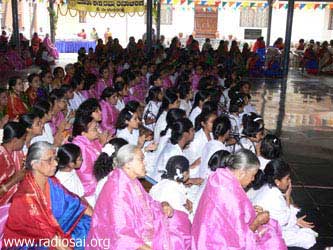 |
|
The children sang about 28 bhajans in the morning. The bhajans were very well selected and rehearsed and the young children sang with aplomb and enthusiasm. The girls lead the morning program with the bhajan Gowri Nandana Gajanana and the boys followed with Sri Sai Natha Guru Govinda.
Then as Swami entered Sai Ramesh Hall, both the boys and the girls sang Dhanya Ho Easwaramba in unison. Bhajans followed in quick succession with the boys and the girls alternating - Jai Jai Janani Sai Janani, Jai Hari Bol Jai Sita Ram, Govinda Krishna Jai, Bhola Bhandari Baba, and Namah Parvati Patale Hara Hara quickly reverberated through the Hall without anyone realizing the passage of time. Other bhajans like Rasavilola Nanadala, Sathyam Gnanam Anantam Brahma, Sundara Vadani, Sai Humara Hum Sai Ke quickly followed and soon about 16 bhajans had been sung.
|
The BV Girls sing for Swami |
|
|
At this time, Swami asked the leaders how many bhajans were left as His eyes were drawn by the preparation activity along the side of the Hall where the morning’s Narayan Seva was going to take place after the conclusion of the bhajan singing. After all, the activity most dear to His Heart is to bring succour to the poor and the suffering. So clearly He wanted to be there among the poor bringing joy and happiness to them.
The children continued singing. Bhajans like Ayodhya ke Sita Ram, Radhe Shyam GopalaRadhika Jivana, Om Namo Bhagavathe Vasudevaya, Dhim Dhim Dhimi Dhimi, Shivaya Namah Shiva and Dum Dum Dum Dum Dhamaru Bhaje were sung with élan and enthusiasm by all the kids. Finally the kids completed their 28th bhajan – Chitta Chora Yashoda Ke Bal and Swami rose gracefully from His seat. He profusely blessed the boys and girls on both the sides of the aisle and slowly got down from the stage and proceeded towards the Kalyana Mantap entrance where the poor had assembled to be blessed by Him.
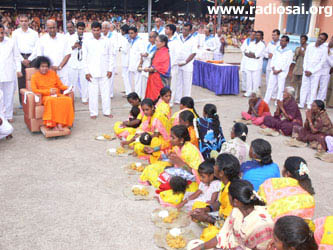 |
|
They had gathered early in the morning and were waiting patiently, for it was also their day. The unfortunate, the destitute, those living on the fringes of society with nothing much to call their own except perhaps the clothes on their backs, their homes on the pavement with the sky as the roof on their heads, had as their sole friend only the Lord Himself.
And they waited patiently, alongside Sai Ramesh Hall while the Bala Vikas children were singing bhajans, waiting patiently for the Lord to become free for they knew that He would then bestow His grace on them, bearing uncomplainingly the Sun beating down mercilessly on their backs - for on this day they were going to be blessed by the Lord Himself.
|
Swami with the people He likes best |
|
|
And then suddenly without much fanfare the Lord was amidst them. Quickly He blessed the food that was going to be served to them - consecrating it as prasadam – a wholesome South Indian fare of sambar (thick lentil soup) rice cooked with vegetables; and also curd (yogurt) rice. He waited and continuously cast His beneficent gaze on all while the seva dal lovingly served these Narayanas, seated in rows with the ladies on one side and the gents on the other.
|
|
|
Blessing the clothes |
|
Placing the chain around the baby’s neck |
After the food service was well underway, Swami enquired about the clothes that were going to be distributed – dhotis for the gents and saris for the ladies. He personally inspected and approved the clothes and blessed that they also be distributed to all.
While the clothes were being distributed He also went around them and blessed everyone. He made a chain for a baby that was lying on its mother’s lap and instructed that the chain be placed around its neck, a talisman that would afford lifelong protection to the young one.
|
|
|
Ladies waiting |
|
A gent with his dhoti |
This distribution of food and clothing is a tradition in Bangalore on Easwaramma day and the word of this event is spread far and wide. But as always happens, there are a lot of people who hear about this late, so do not come in time to be accommodated in the premises before Swami’s arrival. While Swami was blessing everyone assembled in the Ashram premises, a good crowd had also collected outside at the gate and were milling around eager to go in – for a glimpse of the Lord, and also to have His prasadam of food and clothing. And the ever so-patient seva dal volunteers let them in also later and served all of them till everyone was satisfied. Mother Easwaramma surely would have been very pleased at their selfless service! All the Bala Vikas children assembled there also partook of the prasadam later.
The Evening Programme – The Divine Discourse And A Bala Vikas Drama
Swami arrived in the evening to the melodious sounds of the bhajans by the Institute boys. Starting with Sundara Sundara Vinayaka, the boys sang a bhajan next in honour of the Divine Mother – Easwaraamba Priya Tanayaa. These were followed by Raghuk ula bhooshanaa, Giridhaari laal Shyama Gopal, Raama Raama Jaya Raghu kula and Allah Ho Tum. After the end of this bhajan, Swami signalled for Sri Sanjay Mahalingam, who had addressed the crowd a few days earlier to speak again this evening.
Sri Sanjay Mahalingam chose to talk this evening about divine love and its manifestation. He said that beauty, fame, wealth, knowledge of the Vedas, proficiency in poetry and prose, all are of no avail if your mind does not dwell on the Lotus Feet of the Lord! He said, “Pure love for God is immortal, transcendental and eternal. Once divine love is realized, the heart seeks nothing else; it seeks only love, love, love!”
He also recounted a story of how once Swami asked him about his future plans after his completion of his MBA. Sri Sanjay replied, “Swami, Your wish is my command”. To this Swami replied that He was his servant. Naturally Sanjay replied, “No Swami, I am Your servant”. Swami then explained, “I always think about you all. My only wish is your joy. And I am always thinking how I can make all of you happier. Are you also always thinking of me and ask what does Swami want? Hence I am your servant”. Sri Sanjay ended his speech by exhorting everyone to love God with all our heart, mind and soul so we can be claimants of our own heritage.
|
|
|
| |
|
Sri Sanjay Mahalingam talking to the crowd |
After Sri Mahalingam’s talk Swami gave His divine discourse. He said that man comes out of his mother’s womb not with a garland of pearls, rubies or precious stones but with one heavy garland that Brahma gives and that is the garland of the consequences of our good and bad actions (karma) done in previous lives. Hence in our lives we have to discriminate between the good and bad.
We can find fulfilment in human life if we utilize the 5 elements in the right way. This world is called prapancha (a conglomerate of the 5 elements) of sabda (word), sparsa (touch), rupa (form), rasa (taste), and gandha (smell) and these should not be used in an unholy way. We should only perform good deeds with the 5 senses.
Swami said that human life is given to conquer illusion (Ma – Maya, Na – not, and Va – to conduct). At birth, one is free from impurity, but with growth desires also increase. There should be a limit on desires, but man today is crossing all limits without regard of humanness.
Indian principles are noble, but today we are trying to emulate the Westerners. In India, a woman is placed on a pedestal. There is no love higher than a mother’s love. When we love our mothers we achieve great power. Mothers should be well cared for in their old age. Today the children are sending their mothers to old age homes; remember tomorrow you will also be sent there by your own children.
Humanity can blossom only when there is truth and love. Today everyone thinks in a mean way, not a cultured way. We must always think what is good for the society and the country. Culture emerges from the heart. Many great souls have made sacrifices to foster Bharatiya culture like Savitri, Draupadi, Sitadevi and Damayanthi. They looked like ordinary ladies but had great divine power.
|
|
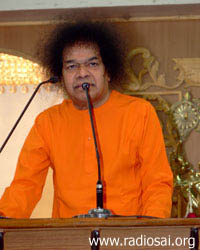 |
| |
|
The Divine discourse |
Truth and divine love are changeless. Love with desire is like a passing cloud, whereas divine love is eternal. Hence keep love as foremost in your life. Truth should be your ideal. You attain sacredness and your life will become fulfilled.
Swami also recounted in detail the story of Ishwar Chandra Vidyasagar. Born in poor circumstances, through hard work he obtained a good education and later got a very good paying job. He then wanted to buy his mother new clothes to wear. She agreed to wear the sari only after two of her desires are fulfilled. She asked Vidyasagar to build a small school for the children of the village and then to dig a well so the women did not have to walk long distances to fetch water. Vidyasagar fulfilled his mother’s wishes. Later Vidyasagar became very famous and thousands flocked to hear him speak.
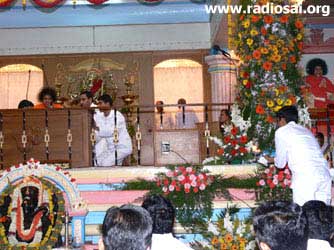 |
|
Once he was travelling to another place to give a speech. In his coach was a Government officer. After reaching the destination, the officer started looking for a porter to carry his luggage but did not find any. Vidyasagar volunteered to carry the same and even refused to accept the money for carrying the luggage telling the officer that he did it as an act of service. The same officer felt contrite when he later found out that the same person on the stage and the person who carried his luggage was Vidyasagar himself. Swami again reiterated that we should always do service to others, and not receive service from others.
Accordingly, said Swami, Sathya Sai also fulfilled Mother Easwaramma’s 3 desires and had a school, a hospital and a well built in Puttaparthi. These have now become a University, a Super Speciality Hospital and a Water project. |
Arathi at the end of the Discourse |
|
|
In conclusion, He said that making mothers happy is the duty of all children. Hence on this Easwaramma Day, cultivate the principle of helping others and find joy and fulfilment in your lives.
A little while later, everyone assembled in Sai Krishan Kalyana Mantap for a drama entitled Bhaktha Sudama presented by the Bala Vikas children of Bangalore. This is a well known story from the Bhagavatham recounting an incident from Krishna’s childhood. The story begins with Sudama (one of Lord Krishna’s playmates at the ashram of their guru) eating Sri Krishna’s share of beaten rice when they were in the forest tending cows. Years later, Sudama (also known as Kuchela) remains a poor man, barely making ends meet. His wife asks him to go to Krishna who is rich and a king and ask him for help. She also gives Kuchela a handful of coarse beaten rice to give as an offering to Krishna.
|
|
|
Sudama eats Krishna's rice |
|
Krishna receives Sudama with honour in His court |
Krishna receives His childhood friend with great honour and seats him and washes his feet. Though a king, He eats with great relish the poor fare sent by Sudama’s wife. Krishna takes good care of Sudama and the friends spend a lot of time recounting the old days. Soon it is time for Sudama to leave and in his happiness he forgets to ask Krishna for help. Sadly he walks back home wondering what he would tell his wife. When he reaches the place where his humble hut stood, he now finds in its place a big mansion and his wife and children are living in abundant prosperity. Krishna had eaten the beaten rice and showered His grace. Unknowing to Sudama, He had made him prosperous. Such is the way of the Lord.
The whole play was well enacted in Kannada, the local language in Bangalore and contained a lot of meaningful and soul stirring songs. Not knowing Kannada, your correspondent requested the Co-ordinator for a detailed English synopsis of the drama so we could fully bring the pleasure shared by the audience for the benefit of the thousands of readers worldwide also. Unfortunately, she was unable to comply with our request in time.
[Heart2Heart requests all people who put up programs in regional languages to please provide us a detailed English language synopsis of the programme. We all try to please Swami but His joy is only in the joy that the audience feels when they witness the glory of God that is portrayed in the drama. Help us share the same joy, enjoyed by the audience witnessing the drama in Swami’s divine presence, with our readers and devotees world-wide also by this thoughtful gesture of providing us with a decent translation.] |
|
|
| |
|
Swami with the children at the end of the play |
MAY 9TH AND 11TH: PRAVEEN SULTANA SINGS IN SAI RAMESH HALL
On May 9th, seeing Ms. Praveen Sultana, the doyenne of Hindustani Music seated amidst the crowd, Swami asked her if she would like to sing to the crowd. Naturally being very delighted at this unexpected blessing, Ms. Sultana sang Meera bhajans. But Ms. Sultana being one of the topmost performing artistes in the country was used to singing with the best accompaniments. Swami asked the students of the Sai Mirpuri College of Music to accompany her. The students (Sri Sanket Modi on the harmonium, Sri Shivakumar on the tabla and Sri Niranjan on the mridangam) were absolutely thrilled to be playing for a singer with such a world-wide reputation. Ms. Sultana then sang 4 Meera bhajans in her own inimitable style for the benefit of the audience – Sakhi ri main to Govind ke guna gaoo (O friend let me sing of the qualities of my Govind); Main to lino Govind mole (I have bought my beloved Govind); Payoji maine Ram rathan dhan (I have attained the incomparable wealth of Rama) and finally Mere to Giridhar Gopal (Beloved Krishna is mine).
|
|
|
Begum Parveen Sultana in concert in front of Swami... |
|
Sanket Modi receiving a ring |
On the 11th, Swami again blessed Ms. Praveen Sultana to sing to the devotees gathered in Sai Ramesh Hall. Choosing to sing the classical Hindustani ragas – she first sang the raga Hamsadvani followed by the raga Bhairavi which included a bhajan to the Goddess Mahisasuramardini. She then concluded her short concert with the Meera bhajan Bhaja Mana, Nanda Nandana Giridhari.
After the concert Swami asked her if the accompaniments especially the harmonium were good. She replied that it was very good (a good harmonium accompaniment is very necessary for her to keep time). Swami beamed like a proud mother on hearing this signal praise of his students performing well in such a setting. He immediately called Sri Sanket Modi, a Music College Diploma student, and manifested a navarathna (nine-gem) ring for him. Truly if you sing solely for the Lord, worldly recognition will follow of its own accord without any seeking.
MAY 13 & 14th VESAK 2006 - BUDDHA POORNIMA CELEBRATIONS IN BRINDAVAN
The First Day
Vesak Day, 2006, the 2550th anniversary of the triple-event of the Birth, the Enlightenment and the Death of Siddhartha - also known as Gautama Buddha, was celebrated in millions of homes in all the lands where Buddhism is practised with the lighting of lamps and elaborately sculpted decorative lanterns, both in homes and in the public streets, the erection of colourful depictions of events from the life of the Holy One and the offering of dana - charity – and of course going to the temples to offer obeisance and seek the Buddha’s Blessing on this the most auspicious of days for the practising Buddhist.
This important Buddhist festival has also been celebrated in Whitefield for more than 10 years for Swami is usually resident in Brindavan when the Buddha Poornima or the full moon night in the month of May rolls around.
|
|
|
| |
|
The decorated altar at Sai Ramesh Hall |
Every year one of the Buddhist countries acts as the chief host for this event of great significance to Buddhists. Last year Sri Lanka was the host and this year it was the turn of Region 41 South East Asia comprising the countries of Malaysia, Singapore, Indonesia and Brunei.
Planning for this mega event started right after the Maha-Sivarathri festival when Bhagavan approved and blessed the proposed Buddha Poornima Programme. A total of 14 countries responded and came to Brindavan – Japan, Sri Lanka, Thailand, Taiwan, South Korea, China, Hong Kong and many Buddhists also came from the countries of UK, USA and South Africa (in addition to the devotees from the 4 host countries) – as early as the 8th of May. In addition 8 Buddhist monks from Sri Lanka and Indonesia also participated in this memorable event.
|
|
|
Some of the Buddhist monks who attended the celebration |
|
The Chinese lanterns on the ceiling |
By the 11th, the devotees started to put up the decorations inside the Ashram premises, including Sai Ramesh Hall, the Kalyana Mantapam and of course – Trayee Brindavan, Bhagavan’s residence. Some speciality decorative items – like the red Chinese lanterns from Taiwan which added a touch of grandeur when hung from the ceiling - were brought from their own countries by the devotees, but in most cases items were bought locally. When the lights were fully lit it was a sight for the Gods to see. The wonderful decorations and the entire campus looked like it had been transformed into a Buddhist country with its many banners displaying the teachings of the Buddha and Swami, the different flags, and the Chinese lanterns. In a corner of the dais an elaborate and intricately decorated altar was set up along with pictures of Shirdi Baba and Sathya Baba.
|
|
|
The Nanyang School Procession |
|
A view of the dignitaries on the stage |
On the morning of the 13th, Bhagavan was led by 12 children from the Nanyang School of Medan, Indonesia in their beautiful red attire and playing beautiful music for the Lord, from His residence to the dais of Sai Ramesh Hall. A lot of dignitaries attended the day’s festivities. Seated on the dais along with Swami were the Sri Lankan Opposition leader Sri Kuru Jayasuriya, the Governor of the State of Karnataka Sri T. N. Chaturvedi and the Governor of the State of Maharashtra Sri S.M Krishna. Also gracing the occasion by their presence were – Sri Rohitha Bogollagama, Sri Lankan Minister for Enterprise Development and Investment Promotion, the Sri Lankan Ambassador to India, the Deputy Governor of the Reserve Bank of Sri Lanka, heads of several industrial groups and prominent citizens of Bangalore who are long time devotees of Swami.
Swami was welcomed with bouquets by the leaders of all the countries hosting the program. Swami then inaugurated this great event by pressing a switch which lit up the entire podium and the Buddhist altars to clapping from the assembled crowd. The celebrations were set on its way by a beautiful rendering of a few bhajans by singers from the host countries. Both the ladies and the gents sang very well and Bhagavan kept beat with the songs. After the bhajans had uplifted the entire congregation, there were a couple of speeches by well-known Buddhist devotees to round off the morning program.
|
|
|
| Inaugurating the function by pressing the switch |
|
Dr. Art Ong Jumsai speaking |
First was an inspiring address by Dr. Art Ong Jumsai, an eminent educationist, a former Member of Parliament and an eminent scientist having worked for the space Agency NASA during the heady days of the moon landing. Dr Jumsai stressed on the loving kindness, the ahimsa and the compassion of Lord Buddha. To the delight of the crowd he also related the story of the Sathya Sai School in Thailand, where 95% of the students are Buddhists and which was recently acknowledged as the “best Buddhist school” in Thailand. Dr Jumsai said that the reason for this achievement was that the students did a lot of seva at the Buddhist temple next door –serving food during festivals, washing plates, cleaning the temple and also arranging discussions on the various aspects of human values. They also had a water project to supply clean water to the community around the school and provided free medical treatment for the nearby villagers at the school’s clinic. Terming ‘educare’ as the discovery of the Buddha within; he outlined 3 steps in Buddhism to achieve this. The first step is Sila or control of the senses. The second step is Meditation and the students wake up at 4:30 AM to do the Jyothi meditation as laid down by Bhagavan. And the third step in Buddhism is Panya - inner wisdom or understanding of the truth of the true nature of man being the Atma, using the human values of Love and Non-Violence.
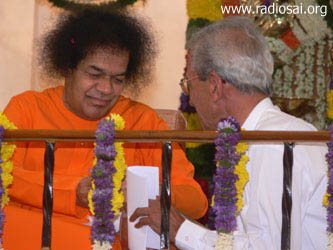 |
|
Next to speak was Sir Bradman Weerakom from Sri Lanka who was the Secretary to the Government and served 7 Prime ministers in Sri Lanka. Sri Weerakom chose to speak on the contribution of Buddhism towards Global Peace.
He said, “The road to peace as expressed in Buddhism needs to have two pathways. The first is the cultivation of the right mental attitudes. The second is the resolution through right effort of the underlying material conditions which give rise to conflict; whether of poverty, or under-development or alienation or exclusion. Improving the human condition so that the poor and the deprived in our societies are provided with the basic necessities of life – like food, drinking water, health facilities and education for the children, which Bhagavan has engaged in so resolutely, is in total fulfilment of this second pathway, so complementary and so essential to building, sustaining and strengthening global peace."
|
Sir Bradman obtaining Swami’s blessings |
|
|
After the arathi, all the delegates were directed to the Kalyana Mantap where a sumptuous lunch was arranged for all the 1100 Buddhist delegates by Bhagavan.
|
|
|
Reciting the brahmarpanam |
|
A luncheon picture partaking Swami's prasadam |
All the delegates were seated (ladies on one side and the gents on the other) for the luncheon which was served in the traditional manner on banana leaves. Everyone thoroughly enjoyed the lunch which was lovingly served by the seva dals and some of Swami’s students. This concluded the morning programme.
|
|
|
The ladies who sang for Swami |
|
The singers on the gents side |
The evening programme started around 4 PM. Welcoming Swami everyday to Sai Ramesh hall were the bhajan singers drawn from the host countries who sang a number of Sanskrit bhajans singing the praise of the Lord. We need to commend these bhajan singers. They had practised a wide repertoire of Indian bhajans just for Swami’s sake. Both the ladies and the gents sang very well and at times Swami sat for as much as a half-hour listening attentively to the bhajans before He would bless the day’s programme to start. And a listener would not have been able to tell the difference from the usual bhajan rendition, such was their level of practise and a reflection of their level of dedication.
After a short while of bhajan singing, Swami blessed the programme to start. The first to speak in the evening was Dr. Narendra Reddy from Los Angeles, California. Dr. Reddy serves as a member of the Prashanti Council and co-ordinates its medical programmes (like medical camps in different countries or the sending of medical teams and supplies to areas affected by natural disasters like the recent tsunami in the region).
Dr Reddy touched upon and amplified the views expressed by the two speakers in the morning and especially addressed the devotees on the significance of this joyous day. He also mentioned the catholicity of the teachings of the Buddha and its relevance to all of us.
|
|
|
| |
|
Dr Reddy talking to the audience |
Speaking next was Brother Phoa Krishnaputra, of Medan, Indonesia, who chose to talk about how with His Grace we can achieve anything. Fortunate in having a loving wife and healthy successful children, he followed a prosperous career with plantation companies and reached the highest level of management. Still there was something niggling deep inside his mind, and he was searching for a cure for his aching heart. He next recounted the story of his life and how he happened to come to India on a pilgrimage to the Buddhist holy places and was lead to Swami; he also recounted Swami’s help and guidance in helping him establish a Sai Centre and a school in Indonesia.
|
|
|
Sri Krishnaputra getting Swami’s blessing before addressing the crowd |
|
Swami blesses the book before release |
After these two speeches, Swami graciously blessed a book entitled “Personal Interactions with Baba My Father’ by Dr (Mrs) Vasantha Jayasuriya, wife of Sri Jayasuriya, a former Minister of Sri Lanka. Swami was also kind enough to release a copy of the Buddha Poornima issue of the Sai Marga magazine. Sri Jayasuriya also extended an invitation to Swami to visit Sri Lanka. After this Swami got up slowly to give His Divine Discourse, while the students scurried hurriedly to set up the discourse table and mike for Him.
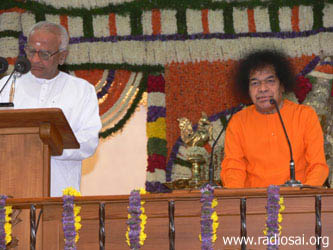 |
|
Swami started His divine discourse by delineating in detail on the life of the Buddha. He mentioned how the Buddha’s parents – Shudhodhana and Mayadevi – performed penance for many years to have an heir to rule the kingdom.
As soon as the son Siddhartha was born, the mother Mayadevi gave up the body and the boy was brought up by the King’s second wife Goutami. At the time of birth, the King’s astrologers predicted that the boy would not rule the kingdom. To prevent this untoward happening, the king shielded the boy by keeping him in the palace itself and isolating him from outside influences. At the age of 20, Siddhartha was married to Yashodhara and they in turn had a son.
|
The Divine Discourse |
|
|
One night there was a sudden transformation in the mind of Siddhartha and he left the palace after caressing his son, Rahul. Siddhartha went to the forest to contemplate and had to undergo a lot of hardship and difficulties. His parents were also suffering from a sense of separation. Swami also added that Siddhartha’s anguish came in the way of his self-realization.
In one town a person gave him a talisman for protection, telling Siddhartha that the anguish actually is from within. (Swami waved His hand and materialised the talisman to the astonished gasps of the audience). The person put the talisman on Siddhartha’s neck and all the anguish vanishes (Swami later in His Discourse also added that the talisman disappeared when the Buddha died).
Siddhartha started doing penance, very long penance. He started questioning – Who am I? Am I the body? Am I the mind? Finally he reached the conclusion that “I am I”. This is also the principle of Aham Brahmasmi – I AM God; and Tat Twam Asi – Thou Art That. Thus, said Swami, Buddha went on enquiring into the truth and reached the true realization that I AM I.
|
|
|
| |
|
Manifesting the protective talisman |
Swami further said that today’s meditation, penance, japa, or yoga gives only momentary satisfaction and is a waste of time. The primary duty of man is to find fulfilment in life. “Without wasting time in meditation, do social work”, said Swami, “and recognise the divinity in everyone. That is true meditation”. He further said, “Every man therefore has to recognise the Truth that I am God, I am God. Every man identifies himself with the Atma. Buddha was the person who had recognised the unity in multiplicity and there was a total transformation in his life when he recognised the unity”.
“What did the Buddha teach?” asked Swami. Answering the question He said that he went on teaching that there is only one principle in everyone. The truth is one, though it may be called by different names. Similarly Krishna also declared - Everybody is part and parcel of Myself. You are My Own reflection. You are not different from Me, said Swami. He further added that every reaction, reflection and resound is one and the same. The Buddha also taught that we should not get angry with anyone. We should not harm others. We should not find fault with others. There is only one principle – eternal, pure and wise. And all of you are Buddhas. And when you understand this truth you see unity everywhere. And so we have to unite our hearts and recognise the spirit of unity. When mind finds and experiences this unity, then man’s life finds fulfilment.
After this arathi was taken; and the devotees were asked to assemble in the Ramesh Krishan Kalyana Mantap for the cultural programme to follow.
|
|
|
The Kwan Yin Dance Front View |
|
...And Side View |
First the 12 children from the Nanyang School of Medan, Indonesia presented a unique dance called “The Thousand Hand Kwan Yin” dance. The Nanyang Modern Indonesian School of Medan, Indonesia, is one of the educational institutions where the ‘Sri Sathya Sai Education in Human Values’ is being implemented in the teaching curricula.
Kwan Yin is the Goddess of Mercy and is revered in Indonesia. The small children dressed in their gold suits gave a very well co-ordinated dance that won loud applause from the crowd. When they stood in a line and moved their heads and hands it looked like they had moulded into one single body. The message conveyed by these synchronised dance movements was that as human beings we are obliged to spread the loving kindness (metta) and helping hands in order to attain global peace and harmony. Following this short dance programme was a drama by the youth of Singapore.
|
|
|
The courtroom Scene from the drama |
|
A scene from the Buddha's life |
The drama was based on the life and teachings of the Lord Shakyamuni Buddha whose teachings emphasized the need for all of us to realize the divinity within and to follow the path of Truth and Righteousness by mastering our five senses. The opening scene was set in the Supreme Court where all had gathered to hear the case of the Government against the Inter-Faith council on the charge that God does not exist. If the Government proves its case without a doubt all references to God in schools and Government policies have to be removed. In an action packed sequence sparking with hard-hitting and well rendered dialogues, the defence attorney wins the case when he proves that the mere presence of evil in the world does not imply that God does not exist.
He made the argument that just as darkness is the absence of light, so too evil reflects the absence of goodness and is a human foible. God is something that can only be experienced and cannot be perceived by the five senses; just as the fact that though we cannot see and feel Oxygen we still continue to breathe. The drama also depicted a scene from the life of the Buddha (wherein He accepted a pomegranate from a poor woman but did not accept gold and precious stones from a king - looking just to the motivation behind the gift rather than its worldly value) to emphasize that we need to purify our minds and hearts if we are to attain Nirvana - the final goal of life according to Buddhism. Swami talked with all the youth who had put up the play before He retired for the night.
The Second Day
 |
|
On the second day Swami came out of Trayee at 9:10 AM and gave darshan to the assembled devotees at Sai Ramesh Hall.
After a few bhajans, the Bala Vikas children of Indonesia presented a traditional Indonesian dance, called the “Welcome dance”, a custom in the area of North Sumatra, Indonesia – in welcoming distinguished guests during festive occasions by the young Sumatran ladies.
The Bala Vikas students aged between 9 to 14 years performed the dance to the delight of the crowd. Following this was a repeat of the Kwan Yin dance from the previous day but now before the larger Sai Ramesh Hall audience. Again the young ladies won the applause of the crowd with their synchronised movements. |
| Welcome Dance |
|
|
This was followed by an entertaining and absorbing Chinese choir presented by Malaysia. All the songs were in Chinese - joyful songs sung in praise of God; songs that expressed that we should experience the joy, love and grace of Bhagavan Baba. The songs were vibrant, expressive, and full of love.
|
|
|
Chinese choir - Ladies side |
|
Chinese Choir - Gents side |
| |
|
|
Though the tunes were unfamiliar and the words incomprehensible - everyone found empathy and unity with the sentiments that were joyfully expressed by the energetic choir.
At the close of the presentation, Swami called Bro. Stanley Cherry, a vocal teacher in Malaysia and the choir conductor and motivator, up to the dais and materialised a golden chain much to the joy of all the members of the choir and the devotees present.
|
|
|
| |
|
A Chain For the Conductor |
Following this Swami blessed the food and the clothes that would be distributed by the Buddhist devotees as part of Narayan Seva and vastra danam. The poor people were all seated in orderly rows and the overseas devotees enthusiastically distributed food to all. In all about 800 people were given food and clothing to conclude the morning programme.
|
|
|
Swami blessing the food |
|
Narayan Seva by the Buddhists |
In the evening the darshan started at 4:20 PM and Swami was again greeted by an inspiring rendition of bhajans by the singers from the overseas devotees. After a few bhajans, Swami gave His blessings for the evening programme to start. The first item was a short rendition by 2 gents on what was termed as ‘Sri Lankan Drums’. These 2 percussionists gave a short but resounding and controlled display that picked up pace very fast so that at times it seemed that their fingers were just a blur playing fast staccato music on the rawhide skin.
|
|
|
Sri Lankan Drums |
|
The final dance item |
The finale item of the two day celebration was a dance put up by the Bal Vikas of Indonesia to the tune of the bhajan “Sai Bhajan Bina Sukh Shanti Nahi”. This traditional Indonesian dance form is called “Mainang Kuala Deli”. It is an entertainment dance performed by the youth in North Sumatra, to share their joy and happiness. Certainly their joy was contagious and everyone went home uplifted and happy at the conclusion of this two day festival of Buddha Poornima.
MAY 16TH: A SITAR CONCERT
When we all came to Sai Ramesh Hall in the afternoon, we noticed that a plush carpet had been laid out in the first block right in front of the dais. All of us immediately suspected that a musical concert was in the offing and we were not disappointed. Slated to play this day was Sri Prabeer Bhattachary, a noted sitar exponent from Kolkata.
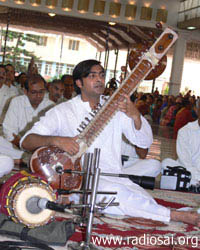 |
|
Sri Prabeer Bhattacharya is a disciple of the great Pandit Deepak Choudhary (Pt. Deepak Choudhary himself is a disciple of Pt. Ravi Shankar). Sri Prabeer had about 17 years of training under his teacher and his playing style is notable for its range of emotions and speed. A rigorous daily practise regimen of 12 hours had made him a maestro of the sitar. Accompanying him this evening were accomplished artists Sri Rajendra Nakoe on the tabla and Sri Srinivas on the mridangam.
Sri Prabeer started his concert with Raag Megh or a raga celebrating the rainy season. (A raag is a combination of certain swaras or notes. In Hindustani music we have seven swaras – Sa, Re, Ga, Ma, Pa, Dha, Ni analogous to the Western Do, Re, Mi, Fa, So, La, Ti). Thus Raag Megh has the swaras Sa Re Ma Pa Ni Sa on the ascending and the swaras Sa Ni Pa Ma Re Sa on the descending.
|
Sri Prabeer Bhattacharya on the sitar |
|
|
| |
|
|
He followed the Raag Megh with Raag Hamsadhwani Malika (or the raga that creates a happy mood) that had the raga Bahar admixed with it. This Raag has on the ascending the swaras Sa Re Ga Pa Ni Sa and on the descending it has the swaras Sa Ni Pa Ga Re Sa.
The last item was the raag Bhairavi that had a jugalbandhi (i.e. The tabla and the mridangam played in turn). This raag has on the ascending: Sa Re Ga Ma Pa Dh Ni Sa; and on the descending: Sa Ni Dh Pa Ma Ga Re Sa.
|
|
|
| |
|
The concert in progress |
Our readers might also be pleased to know that this young artiste Sri Prabheer Bhattacharya is also a Visiting Professor at the Sai Mirpuri College of Music and spends a couple of months every year sharing his immense talent and skill with the young and eager students.
MAY 19TH - 21ST: A 3-DAY KERALA YOUTH SADHANA CAMP
A sadhana camp was held for the Sai youth, students, teachers, doctors and paramedical professionals of Kerala on the 19th, 20th and 21st of May, 2006. About 1800 participants (which includes 300 doctors and paramedics) attended the camp from all the 14 districts of Kerala.
This was the fourth Youth Camp in as many years, riding high on the crest of the phenomenal success of the earlier meetings. Youth of the state of Kerala drawn by the all- attractive love of Swami, came in phenomenal numbers to spend three exclusive days at the Lotus Feet, three days of love speaking its universal language, making use of their summer vacations from schools and colleges or else leave from their employers.
|
|
|
Lady participants at the camp |
|
A view of the Gents side |
They put up lightly with physical hardship and inconvenience suffused with devotional fervour and the contagious enthusiasm and response to the love that Bhagawan showered on them; for in this Avatar the Lord has chosen the youth of the world to be the instruments through which He will accomplish His Mission of transforming society.
It was a very tightly packed three-day programme. They would come early and take their allotted seats in Sai Ramesh Hall, both for the morning and the evening darshan. Speeches and Music Programmes were planned in Sai Kulwant Hall in the Divine Presence on all the three days. Additionally, after about an hour’s break for breakfast after the morning darshan, the numerous participants would meet in the Sai Ramesh Krishan Kalyana Mantap for “classes” where the staff and some chosen graduate students of the SSSIHL, or a few elderly devotees would speak to them. They would then break for lunch at around 1:00 PM and again re-assemble at 2:00 PM in the Kalyana Mantap for one more “session” before re-assembling again in Sai Ramesh Hall for the afternoon’s darshan and activities. We bring you a report on all the numerous speeches and talks, so you too can also get a flavour of the blessings received by the Kerala Youth during these three days. This has made our report a little long but we hope you will understand our indulgence and appreciate the motivation behind it.
The First Day
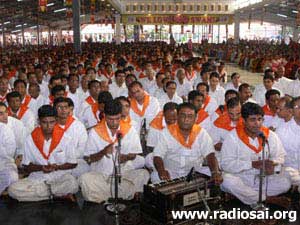 |
|
Amidst bhajans led by the Kerala Bhajan group, Bhagavan came to the stage at 8.50 AM. Bhagavan was welcomed to the richly decorated auditorium with the accompaniment of Nadaswaram. Apart from the floral decoration to the dais, there hung on both sides the traditional Kerala Villakku - the oil lamp, but with a modern touch of having small electric bulbs in place of wicks fed by oil.
The Kerala Bhajan Group had 10 gents (5 lead and 5 followers) and 10 women (again 5 for the lead and 5 followers) drawn from across the State. The vocals were ably accompanied by the Harmonium, the tabla, the Violin and a Timer Instrument. The Bhajan group had the signal honour of welcoming Swami to the Hall for every darshan, and they responded magnificently to the occasion. |
The Gents' Bhajan Group |
|
|
Starting with Vigna Vinasaka, they moved into Sathya Sai Rama and Prema Swaroopini. Jaya Krishna Kunja Bihari and Shiva Shiva Shiva Shiva quickly followed. The sarva dharma bhajan Rahiman Rahiman was next, followed by Gangadhara Hara and Gana Gana Neela, at which point Bhagavan gave the signal for the morning programme to start.
|
|
|
Swami inaugurates the conference by pressing a remote button |
|
Dr Koushik Narayan presents the book for release |
Prof. E. Mukundan, State President of the Sathya Sai Seva Organisations of Kerala, in his introductory remarks thanked Bhagavan for the glorious opportunity of holding the Sadhana Camp in the Divine Presence for the fourth consecutive year.
The first programme was the release of a book entitled “Helpline on the Sathya Sai Path” – a book of questions and answers by Sri B. N. Narasimha Murthy, Warden of SSSIHL hostel at Brindavan, compiled by Dr. Koushik Narayan - a member of the Kerala Youth Wing.
The book is based on the questions and doubts raised by the Sai Youth of Kerala in the previous three youth camps. Bhagavan graciously accepted the book and blessed it with His Divine Signature.
Then the State President, Sri Mukundan, introduced the two speakers of the morning – two Hon. Judges of the High Court of Kerala – Justice Thottathil B. Radhakrishnan and Justice Padmanabhan Nair.
|
|
|
| |
|
The book that was released by the Divine Hands |
| |
|
|
Justice Thottathil Radhakrishnan said that his desire as a student to participate in the Summer Course on Spirituality and Indian Culture held at Brindavan came alive that day with the youth of Kerala. With Swami’s permission, he narrated how he was saved from the disaster of the recent tsunami, without even knowledge of the disaster.
His family had been to the Andamans; the giant waves of the tsunami had hit the shore a few minutes after they had disembarked from the ship, and the ship was washed away. They did not even know of this unfortunate turn of events, and came to know of the disaster only on returning home.
He advised the youth to remain committed to the motherland, as mother and motherland are greater than even the Heavens. He added that India’s wish to be a sovereign, socialist, secular, democratic republic would be fulfilled in full only if the five human values of the Sai Philosophy are put into practice.
|
|
|
| |
|
Justice Thottathil speaks to the participants |
| |
|
|
 |
|
Justice Padmanabhan Nair expressed his fortune at having been able to come to Swami for the first time and speak in the Divine Presence. He also added that the educational, medical and water projects of Bhagavan are one of their kinds in the world and are pristine examples for humanity.
It is for us to emulate those ideals and practise it in our own small way. The youth are fortunate to be at the Lotus Feet of the greatest Master and Mentor.
He added that we have to put this opportunity to the best use for individual and social transformation. Bhagavan materialized vibhuti for both the judges.
|
Justice Padmanabhan Nair receives vibhuti |
|
|
| |
|
|
A musical offering by Sri Madhu Balakrishnan, the renowned Malayalam playback singer, was the next item. He chose to sing popular Malayalam devotional songs; there were also a couple of songs on Swami.
Starting with Maha Ganapathim, he launched into the Malayalam Oru Yugam followed by Mahadeva Shiva Shambho and Radha Than Premam. This was followed by the keertanam - Dasa Dasa and the Malayalam Karuna Chei Van.
After a couple more devotional songs, he ended with a composition on Swami entitled Ellam Ennikende. Sri T.S. Radhakrishnan accompanied the vocalist on the harmonium, Sri Rajesh on the flute, Sri Selvam on the tabla and Sri Shankar on the mridangam. The session concluded with Mangala Arathi at 10 AM.
|
|
|
| |
|
Sri Madhu Balakrishnan sings for all |
Then the participants proceeded to the “Sadhana session” at the Sai Krishan Kalyana Mandapam, where the teachers of the SSSIHL and other elders addressed them.
The first speaker was Sri B. N. Narasimha Murthy, Warden of the Brindavan campus. The revealing message was the recent declaration by Bhagavan, “The one who loves this beautiful form of Sai is My Jeeva-prajna; the one who works relentlessly for me in My Jeeva-prajna.” He narrated many experiences to illustrate the Infinite Love of Bhagavan. If the youth hold on to Swami’s Feet, all their desires will be fulfilled and they will attain inner peace.
The next speaker was Dr. Narendranath Reddy, the Chairman of the International Medical Committee of the Prashanti Council. Once Swami told him in response to a doubt, “If you have intense longing for me in your heart, it means that you love me.”
The next speaker, Dr. T. Ravikumar, a faculty member of the Dept. of Chemistry, SSSIHL, narrated many experiences to demonstrate the various ways of Bhagavan in reforming His devotee. He also narrated how Swami cancelled his father’s cancer.
The post-lunch session at the Kalyana Mandapam had a lecture by, Sri Vijay Menon, a consultant and trainer of Human Resource Development and a member of the Sai Youth Wing of Kerala.
Speaking in Malayalam, he said that only a self-ignited value system orientation can lead us to Swami. Swami gives us both material and spiritual gains. It is for us to decide what we want.
|
|
|
| |
|
Sri Vijay Menon adresses the participants in the Kalyana Mantap |
In the evening session at Sai Ramesh Hall, the Bhajan Group welcomed Bhagavan again. This time the group could sing about 10 bhajans (which included Jay Ganaraya, Radhey Govinda Hare, Rama Hare Sai Krishna Hare, Shivaya Nama Shivaya and a few others) in the divine presence before He asked the afternoon programme to start.
 |
|
Bhagavan blessed four members of the Kerala Youth wing to speak. The programme commenced with Veda chanting by the numerous Sai Youth of Kerala.
The first speaker of the afternoon, Sri Vijay Menon highlighted Indian culture to be so deep that even mighty kings sought refuge in its saintly wisdom for protection.
Along with the growth of science, ignorance has also increased thus the effect gets balanced out so that no real effect is felt. We must be personifications of a value and virtue system as taught by Gandhiji. It is ultimately the dharmic consciousness that finally matters. |
Vedam Chanting before the start of the programme |
|
|
The second speaker was Kum. Nadiya, the Mahila Youth In-charge of Chalappram Samithi, Kozhikode. She described the benefits that she derived out of active participation in the Sai Organisation. She thanked Bhagavan for the unique chance that the youth have obtained, to be the instruments of individual and social transformation.
|
|
|
Kum. Nadiya receiving His blessings before speaking |
|
Kum Anjali addresses the youth |
The third speaker was Dr. Koushik Narayan, State Gents’ Coordinator of Education, Kerala. He elaborated upon the impact of the previous three Sadhana camps on the Sai youth of Kerala. Today’s youth are attracted only to the petty and transient pleasures of life; they do not bother about matters of greater significance. It is in this context that the Sri Sathya Sai Seva Organisation, Kerala gives them the ultimate experience of Divinity Itself. He also narrated a touching incident as to how Swami came to a group of young Sevadals in the guise of a young boy.
The fourth speaker, Kum. Anjali Ajay, explained how Swami helped her throughout her academic and personal life. She also shared the Sai activities that she participated in and the benefits she derived out of them.
This was followed by a speech by Dr. Anand Mohan, State In-charge of the Medical Cell. He said that Swami is the Apoorvavaidya who cures the malady of desire, delusion and attachment.
The principles of health care as elucidated by Bhagavan – globalisation of health care, decommercialisation of medicine, human values in medical practice - have demonstrated to the world that health is primarily a spiritual concept.
The materialization of these concepts through the Super Speciality Hospitals, General Hospitals and the medical centres and camps held all over the world is unparalleled and unprecedented in human history; and perhaps may be unrepeatable in future. Swami has shown to the world that when Universal Love manifests, miracles occur.
|
|
|
| |
|
Dr. Anand Mohan talks about health care |
This was followed by a musical presentation by Sri Madhu Balakrishnan again, at the end of which Swami materialized a golden ring for the singer.
The Second Day
On the second day morning, amidst bhajans led by the Kerala Bhajan group, Bhagavan came to Sai Ramesh Hall at 8.20 AM. The Bhajan Group welcomed Him with three bhajans – Vinayaka Vinayaka, Keshava Madhava, and O Baba Sai Baba, before He signalled for the morning programme to start.
 |
|
The State President introduced the speaker of the morning session Dr. Ramachandran Nair, the revered Vice Chancellor of the University of Kerala.
He exhorted the youth to make the best use of knowledge by integrating the resources of man, material and money in a very positive manner. This leads to the prosperity of the nation. Sincerity, commitment, devotion, love and affection are very important in this regard.
The present generation is missing the inheritance of wisdom and the blessings of the previous generation. The youth have to develop the qualities of leadership, communication skills – verbal, written and body language, ability to motivate oneself and others and above all, creativity. At the end of the speech, Swami materialized a golden chain for Dr Nair. |
A gold chain for Dr Nair after his speech |
|
|
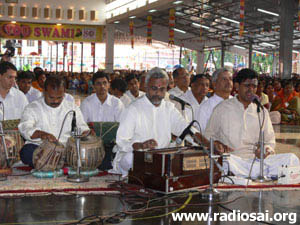 |
|
A Carnatic musical offering by Sri Harihara Subramanyam followed. The young promising artist was previously a Bal Vikas student. Most of the krithis were preceded by a soul-stirring viruthams. Starting with Vattapi Ganapathim, he next sang Karunai Daivame, and then Eppovaruvaro. He concluded with a special composition on Swami called Sai Sai Sairama. The programme concluded with Mangala Arathi at 9.10 AM.
Dr. Deepak Anand, a faculty member of SSSIHL, addressed the first morning session at the Kalyanamandapam. He advised to dedicate all the impurities of our heart at the Lotus Feet of Swami and remain ever focused on Him. He will accept them and transform them into Divine Love. Then only can we merge in the Supreme Divine Love. |
Sri Harihara Subramaniam sings with feeling |
|
|
The second session was by Sri G. Srirangarajan, a faculty member of SSSIHL. The human body along with its talents and potentials is Swami’s prasadam to us; our duty is to return it as naivedyam to the Swami in all in the form of service. This constitutes the “Prasadam-Naivedyam cycle.”
The next speaker was Prof. Sanjay Sahni, Principal of the Brindavan campus of the SSSIHL. He stressed on the importance of sense-control and mind-control. The two golden injunctions on this path are – talk less, have minimum connections.
In the post-lunch session at the Kalyana Mandapam, Dr. Ramachandran Nair, revered Vice Chancellor of the University of Kerala addressed the camp participants. He said that evil qualities easily conquer us; on the other hand, it is difficult to cultivate virtues.
Just because the path of evil is easy, one cannot afford to accept it; one must take the effort to cultivate virtues. In today’s world, only Sai’s glory can bring about transformation; all the mega Seva Projects of Bhagavan are role models for humanity to follow. |
|
|
| |
|
State President Mukundan co-ordinating the sessions in the kalyana mantap |
| |
|
|
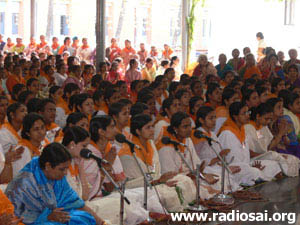 |
|
In the evening at Sai Ramesh Hall, Swami came as the Youth of Kerala rendered mellifluous bhajans. The bhajans included Hari Sri Ganapathi Om, Jaya Jaya Rama Janaki Rama, Sarva Dharma Priya Deva and a couple more.
The programme commenced with Veda chanting by the Sai Youth of Kerala. The State President introduced the two youth speakers of the afternoon and the dignitary, Sri Radhakrishnan, Hon. Vice Chancellor, Sri Sankaracharya Sanskrit University, Kalady, Kerala, who also addressed the gathering. |
| The Ladies' Bhajan Group |
|
|
|
|
|
Sri Manoj receives Swami's blessings before his speech |
|
Kum Divya shares her views |
The first speaker Sri Manoj shared the lessons that he learnt at the previous Sadhana camps. He said that knowledge must be attained not by learning the pusthaka (the book) by rote, but by exercising the faculty of masthaka (the head) that the Lord has bestowed upon us. He added that the youth must possess the head of Sankaracharya, the heart of the Buddha and the hands of Janaka Maharaja. He elaborated upon the benefits that he derived upon participating in the Grama Seva and concluded by saying, “Living with God is education. Living for God is devotion. Living in God is true bhakti.”
The second speaker Kum. Divya appealed to the youths to become like a flute in the hands of the Lord. The flute is straight and hollow; if we are also like that, the Lord will take us into His Hands, fill His Breath into us and will play His melodious music through us that will delight the world. She also elaborated upon the benefits of selfless seva. She also thanked Swami for the unique opportunity bestowed upon the Sai Youth of Kerala.
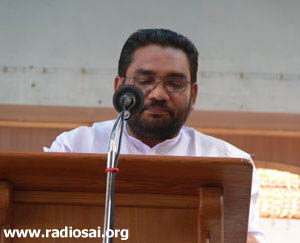 |
|
Sri Radhakrishnan, the revered Vice Chancellor, began by saying that Bhagavan’s very presence infused confidence in the devotees. He commented that the decadence of human values in all walks of life that we see today might be compared to the battle of Kurukshetra.
Bhagavan Baba is doing to the world what Krishna did for Arjuna. He exhorted all to go beyond the religious level, and rise to spirituality. Being religious alone, one sometimes gets entangled in rituals, on the other hand, spirituality infuses in us the greatest confidence.
Baba’s projects have established education and health to be service activities and not commercial activities. Life is not a problem to be solved, but a harmony to be enjoyed; this is possible by adhering to Swami’s teachings of Love and Compassion.
|
Sri Radhakrishnan talks to the youth in the
divine presence |
|
|
Carnatic musical offering by Sri Harihara Subramanyam, the same artiste who had sung in the morning also, followed this speech. In the afternoon, he sang the Thyagaraja KirthiManavyalakinchara, followed by Muralimanohara and NeerajaDalanayana. He concluded with Swagatam Krishna. At the end, Bhagavan materialized a golden ring for the musician. The programme ended with mangala arathi.
Thereafter, Sri Radhakrishnan, Hon. Vice Chancellor, Sri Sankaracharya Sanskrit University, Kalady, Kerala, addressed the participants at the Kalyana Mandapam. The purpose of all sadhana is to ensure optimum use of all resources, by putting a ceiling on desires. One has to go by the way of Shreyas, not Preyas.
The Third Day
On the third day morning, Bhagavan came to Sai Ramesh Hall amidst bhajans by the Sai Youth. Starting with Pashupati Thanaya, they sang two more bhajans – Hey Madhava hey and Devi Sai Ma, before Swami blessed the programme to start.
The speaker for the morning session in Sai Ramesh Hall was Sri Jyothilal IAS, Executive Director, Rural Water Supply and Sanitation Project, Govt. of Kerala. He narrated his transformation from IAS to SAI. In today’s world he said, IAS implies – I first, Any other person next, Service last. However, SAI implies - Service first, Any other person next, I last. He narrated how, as a boy of eight years, he escaped from the face of death due to an attack of meningitis.
He was not Swami’s devotee then, but his father had prayed to his family deity Shiva and his mother had prayed to her family deity Shakthi. Bhagavan, the Shivashakthi Swaroopa came to his help, even without his knowledge. Meningitis is notorious to produce residual intellectual defects, but in his case, the opposite occurred. He developed a particular determination, began to study harder and studied in the IIT and completed his IAS – the dream aspirations of intelligent students.
|
|
|
| |
|
Sri Jyotilal shares his experiences |
He narrated many instances to show how Swami helped him to solve various problems related to his profession and saved him from many dangers. He concluded by advising the youth to utilize fully the excellent opportunity at the Lotus Feet of Bhagavan. Bhagavan materialized vibuthi for the speaker.
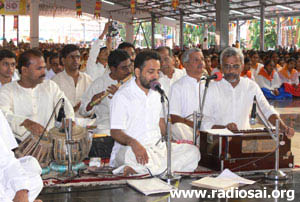 |
|
What followed next was a devotional musical offering by Sri Kavalam Sreekumar and Sri T. S. Radhakrishnan. In addition to compositions of Bhadrachalam Ramdas and Meerabai, there were songs on Bhagavan composed in Malayalam. Kavalam started with the song Vinayaka Vinayaka and followed it with the Malayalam Vaanii Swari Sai.
Sri T. S. Radhakrishnan then sang the song Anda kat a ham. Sri Kavalam Sreekumar then sang a Bhadrachalam composition entitled Rama Jogi Mandu and a Meera bhajan Man Re Parsi. Sri T.S. Radhakrishnan then sang the last song of the morning called Aavinam Kudi. They were ably accompanied on the flute by Sri Rajesh and by Sri Selvam on the tabla.
|
| Sri Kavalam Sreekumar (on the left) and Sri Radhakrishnan sing for Swami |
|
|
The morning programme in Sai Ramesh Hall then concluded with Mangala Arathi.
The first speaker of the sadhana class in the Kalyana mandapam was Sri N. Dhakappa, State President of the Sri Sathya Sai Seva Organization of Karnataka. He narrated a few personal experiences revealing the Omnipresence, Omnipotence and Omniscience of Swami. He added that the best sadhana for the Kali Age is to involve ourselves actively in the activities of the Sai Organisation.
The second session was by Sri B. N. Narasimha Murthy, Warden of the Brindavan Campus. He gave the four golden guidelines in the path of spiritual evolution –
“Look back and thank God
Look ahead and trust God
Look around and serve God
Look inside and see God.”
|
|
|
| |
|
Sri Dhakappa inspires the Youth in the Kalyana Mantap |
He also narrated many experiences from his personal life to demonstrate these statements.
The third session was by Sri Sanjay Mahalingam, a research scholar at the SSSIHL. He said that the only way of liberation is to experience the pure love within. The most important step in this regard is to conquer the three kinds of attachment – worldly, intellectual and spiritual.
In the last session of the morning, Sri B. N. Narasimha Murthy clarified many of the doubts raised by the participants of the Sadhana Camp.
In the afternoon, Sri Ruchir Desai, faculty member of the Dept. of Commerce, addressed the participants. He stressed that the key element of transformation is a change in attitude. He also narrated an experience to show Swami answers to even a flash of thought in the devotee’s mind. He also answered many of the questions of the participants.
In the evening in Sai Ramesh Hall, Swami came to the stage, as the Kerala Bhajan Group was singing bhajans. He walked among the Sai Youth, graciously accepted their letters and materialized vibuthi for some of them.
All the while, the bhajan singers continued singing their bhajans. In all they sang 11 bhajans which included Gajanana Gajanana, Radha Ke Natavarlal, Sai Baba Tera Naam, Bolo Jai Jai Kar, Mrityunjayaya Nama Om, Hara Shiva Shankara, and Rasa Vilola Nandalala.
|
|
|
| |
|
Swami is pleased at the progress of the conference |
Bhagavan is all His Mercy and Compassion then delivered the Divine Valedictory Discourse for the Youth Camp. Starting with a small padhyam (a poem), He said,
“He is present in all beings as peace; All names are His; He is Sat Chit Ananda Swarupa; He is Truth, Auspiciousness and Beauty (Sathyam, Sivam, Sundaram)”. Swami also said, “I am extremely pleased at the happiness you have experienced in the last 3 days. These 3 days passed off beautifully as 3 minutes. Your hearts are sacred filled with devotion, joy and steadfastness. Such meetings should be held f or the welfare of society.”
Touching next on the importance of good company, Swami said that only the Self is present in all beings. Plain paper has no smell but takes the smell of whatever is wrapped in it like vegetables, fruits or dry fish. Likewise, the heart is pure, selfless and steady. However, due to the company it gets polluted. So avoid bad company, be in the company of people with sacred thoughts, get a good name, and lead a good life. He said that the Buddha also exhorted “Buddham Charanam Gacchami, Sathyam Charanam Gacchami” – take refuge in Dharma, take refuge in Sathya.
Swami also said that there is only one God, and He resides in everyone. Just as there are many kinds of sweets, but sugar is one, so too the Atma is one though there are many names and forms. When you think that whatever happens to you is for the good then all good things happen to you. |
|
|
| |
|
The Divine Discourse |
Addressing the Kerala youth, Swami said – Be courageous. Acquire truth and love. Your activities and songs of these past 3 days are very good and beautiful. Whatever you do with love always bears fruit. If you close your eyes and call upon Rama, filling your heart with joy – then you can see Rama yourself. God has no desires. God always loves. Being in society, have the attitude that you are serving God through society. Everything is God. There is nothing in the world that is not God.
He further said that always be with the feeling of oneness that I AM I. After the body goes, what remains ultimately is the I. Only the I is eternal. He concluded the discourse by stating there is only one bondage between Swami and you and that is love. He also added that your Love is reflected in Me and I (am reflected) in your love. “I accept your love and shower my love on you. Live with joy and happiness”.
He concluded with the bhajan “Prema Mudita…”
A devotional song by Sri Kavalam Sreekumar followed the divine discourse to conclude the valedictory function of a memorable 3-day sadhana camp. It was truly a once-in-a-lifetime opportunity for all the participants for Swami’s love was manifest throughout. Though they had to put up with many physical inconveniences, it was all forgotten as they were completely drenched by His divine love. Swami even provided free food for all the participants during their stay in Brindavan. Truly, love is the only bondage between God and His devotees!
[Heart2Heart would like to gratefully acknowledge that the State President of the Kerala Sathya Sai Seva Organisations, provided to us the brief summaries of the speeches given by the youth, staff, students and elders to the participants of the Sadhana Camp.] |
|
|
| |
|
Partaking of Swami's prasadam |
A NOTE ON THE TRAYEE SESSIONS
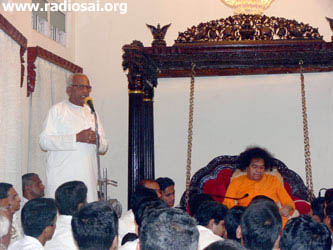 |
|
Any report on Swami’s stay in Brindavan will be incomplete without mention of the “famous” Trayee Sessions. Right after the evening programme the students who have elected to spend their holidays with the Divine, the University staff still on the Ashram and a few chosen elders are invited into Swami’s home - Trayee Brindavan.
It is a unique privilege and an honour that everyone cherishes. The wait is full of anxiety – Will He invite us in today? - and when the signal is given, the boys scramble to get a vantage position next to the Lord Himself, and the Lord is seated majestically on His swing at one end of the room waiting for the boys.
|
Swami speaks while the Warden translates |
|
|
No two sessions are alike except to say that Swami is always at His informal best. Some sessions are serious with usually an elder or a staff member or a chosen student giving a speech and Swami sometimes adding a few comments of His own. Sometimes Swami chooses to speak Himself (with the Brindavan Warden translating) - either amplifying or reiterating His comments that He may perhaps have made in a public discourse earlier or else making points that He feels need to be told to the boys. Some sessions are just hilarious wherein He asks those who do not normally lead the bhajans to sing and as you can imagine it gives ample scope for merriment.
Most times He just converses with the boys or the elders asking and enquiring, cracking a few jokes but always delivering a message of spiritual import even in the most light-hearted banter. And in an understated fashion His divinity manifests at times, as for example, when He gently corrects a fact in a story that a boy is relating thus revealing His omnipresence.
And of course, no summer’s ‘Trayee Session’ story is complete without a mention of the eye-popping manifestations that He so casually accomplishes – bringing forth Lord Rama’s ring, Mother Sita’s chudamani and so on just to motivate the boys along the spiritual path. And sometimes He just talks to the boys like the Father that He is telling them that He loves them and that He is preparing them for the roles that they have to play in the future to bring about a transformation in society. And the sessions usually begin and end with the taking of letters – the fervent appeal to the Lord that is a unique privilege available to all of us.
|
|
|
| |
|
Reading a letter from a young one |
And of course, the most generous Lord always sends us all off from His abode with His prasadam - either a sweet or a mango, yet another small way to show how much He loves all of us. And it is this very love for all of us for that has brought Him down to earth to redeem humanity.
IN CONCLUSION
 |
|
There is a unique ‘race’ that happens at the end of every programme in Brindavan. As the arathi song is getting over, and the strains of “Om Shanti Shanti Shanti” are fading, a few Seva Dals hurry to roll some barricades from one end of the Hall and put them in place before the deity of Lord Ganesha in the front of the Hall under the dais. And simultaneously a few enterprising ladies also hurry in a similar fashion. They have a narrow window of opportunity - just the time that it takes the Seva Dal to roll the barricades down - to go up to Lord Ganesha and take His padanamaskar before He becomes “unavailable”. And soon it is a scramble. And the seva dal does have a problem on his hands.
He tries to shoo the ladies away so he could put the barricades in place. While the ladies in front try to obey him (as they have already taken Lord Ganesha’s blessings) the ladies from behind are unwilling to give ground in their attempts to reach His feet. I wonder what Lord Ganesha, sitting serenely in His place, thinks about all this confusion that happens right at His Lotus Feet.
|
| Putting the barricades in place |
|
|
While this story has its bit of humour; it is also a powerful commentary at the same time. The Avatar has been with us for 80 years and the ‘window of opportunity’ is fast narrowing. Are we also hustling to reach His Lotus Feet and hold on to Them before the barricades are in place and He becomes unavailable? Do we have the same urgency to intensify our sadhana so that we attain Him and realize the purpose of our life? Or are we taking a laissez-faire attitude thinking there is always tomorrow and wasting yet another day, yet another year, and yet another lifetime!
Think about it. Swami’s airplane is getting ready to take off. Have we ‘earned’ our boarding passes yet!
So till next time; Jai Sai Ram.
- Heart2Heart Team. |





